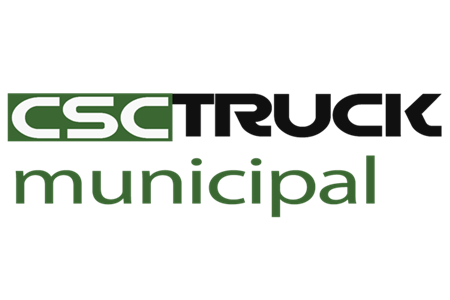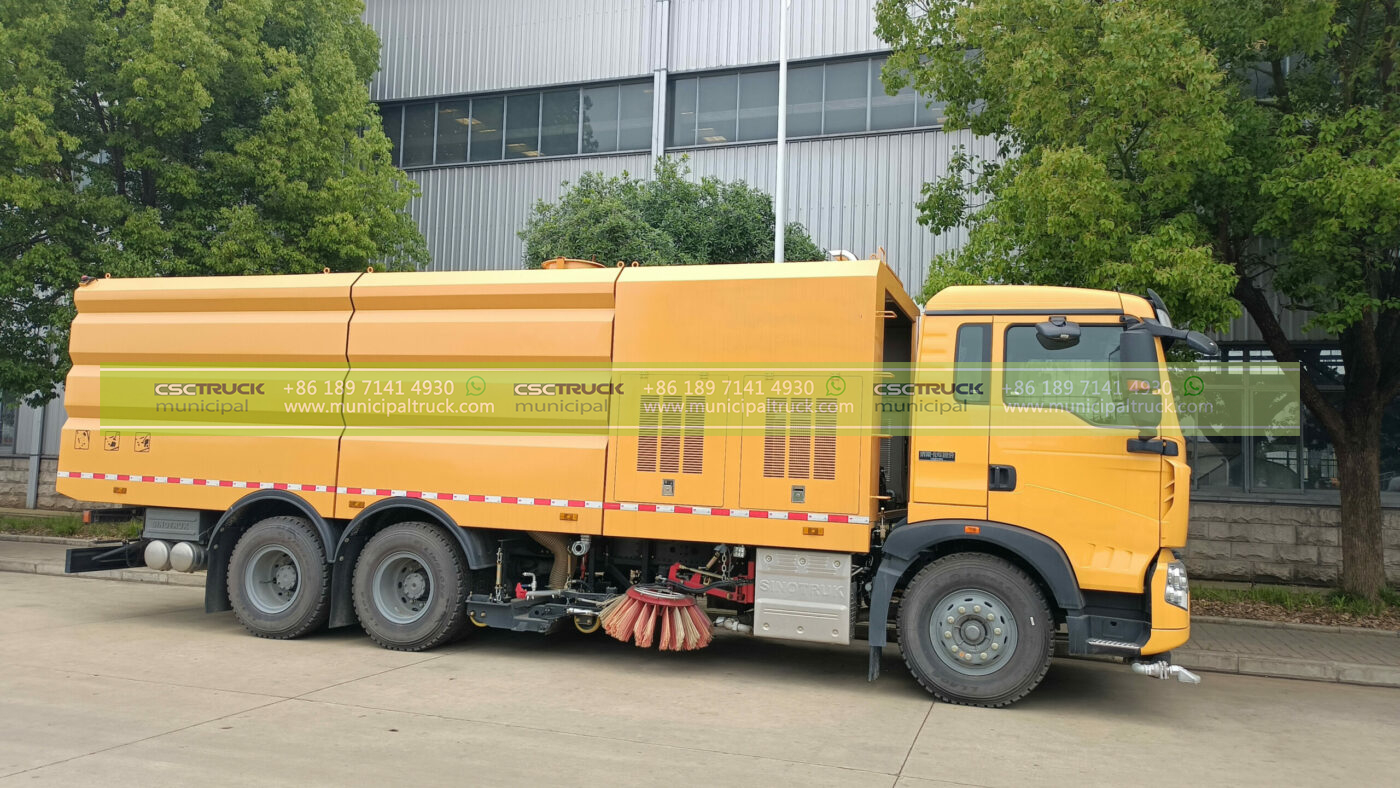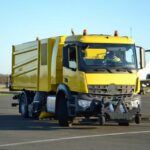Introduction: The Critical First Line of Defense on the Tarmac
Every day, millions of passengers worldwide place their trust in the complex ballet of aviation. While pilots, air traffic controllers, and sophisticated navigation systems capture the spotlight, a crucial player operates largely unseen on the vast expanse of the airfield: the airport sweeper truck. This specialized vehicle is far more than just a large-scale cleaner; it is an indispensable tool in the relentless pursuit of aviation safety and a cornerstone of FAA compliance for airports operating under 14 CFR Part 139 certification. Its role in mitigating Foreign Object Debris (FOD) – any object, live or not, located in an inappropriate location within the airport environment that has the potential to cause damage to aircraft, personnel, or equipment – cannot be overstated. A single small piece of debris ingested into a jet engine or damaging a tire during takeoff or landing can have catastrophic consequences. Ensuring these powerful machines and the protocols governing their use adhere strictly to Federal Aviation Administration (FAA) mandates is not merely operational procedure; it is a fundamental commitment to protecting lives and assets. This deep dive explores the intricate relationship between airport sweeper trucks and the stringent requirements they must meet to keep our skies safe.
Understanding the FAA Mandate: Part 139 and the Imperative of FOD Control
The regulatory foundation governing airport operations in the United States is 14 CFR Part 139 – Certification of Airports. This comprehensive regulation outlines the minimum safety standards required for airports serving scheduled and unscheduled air carrier aircraft with more than 30 passenger seats. Central to Part 139 is the unequivocal requirement for airports to maintain a safe operating environment, explicitly including the mitigation of Foreign Object Debris (FOD). Key sections underscore this duty:
- § 139.329 Pedestrians and Ground Vehicles: Mandates procedures to protect pedestrians and ground vehicles, implicitly requiring measures to prevent vehicle-derived debris and ensure sweeper operations themselves don’t become hazards.
- § 139.311 Marking, Signs, and Lighting: While primarily about visibility, proper markings are crucial for safe sweeper truck navigation on complex airfields.
- § 139.337 Public Protection: Requires fencing and procedures to deter unauthorized persons and animals, indirectly impacting FOD sources.
- § 139.313 Snow and Ice Control: Though focused on winter operations, the principles of rapid removal and maintaining surface friction apply year-round, often involving sweepers in debris removal post-deicing or after storms.
- § 139.319, § 139.321, § 139.323 (Runway/Taxiway Conditions): These sections place the ultimate responsibility on the airport operator to ensure movement areas are “suitable for operations,” explicitly requiring the airport to conduct surface condition assessments and remove any contaminants – including FOD – that could adversely affect aircraft operations. This is where the airport sweeper truck becomes the primary tool for proactive and reactive FOD removal.
Failure to maintain effective FOD control programs, underpinned by reliable sweeping operations, can lead to FAA findings, corrective action orders, and, in severe cases, suspension of an airport’s operating certificate. The financial and reputational damage from such events is immense. Therefore, FAA compliance is intrinsically linked to the effectiveness of the airport’s sweeper fleet and its operational integration.
Engineering for Compliance: Design and Capabilities of Modern Airport Sweeper Trucks
Not just any sweeper will suffice for the demanding environment of an active airfield. Modern airport sweeper trucks are sophisticated machines engineered specifically to meet the unique challenges of FOD removal under FAA scrutiny:
- Robust Construction & Airfield Compatibility: Built on heavy-duty chassis (often derived from refuse truck or severe-duty vocational platforms), they withstand constant vibration, potential impacts from debris, and long operational hours. Ground clearance is paramount to avoid becoming FOD themselves or damaging airfield infrastructure like embedded lights. Components are shielded to prevent detachment.
- High-Efficiency Sweeping Systems: Employing powerful mechanical broom systems (main and gutter brooms) often combined with vacuum suction, these trucks must effectively capture a vast range of debris sizes and types – from tiny metal shavings and gravel to larger items like cargo netting fragments or broken pavement chunks. Debris retention systems (large hoppers) are essential for containing collected FOD until proper disposal.
- Durability and Reliability: Airports operate 24/7, often in harsh conditions. Sweepers must be highly reliable, minimizing downtime. Critical systems often feature redundancy, and ease of maintenance is a key design consideration.
- Operator Safety and Visibility: Enclosed, reinforced cabs protect operators. Excellent 360-degree visibility, often enhanced by cameras and proximity sensors, is crucial for safety in congested ramp areas and near active runways. High-intensity lighting and aviation-specific paint schemes (often yellow with black striping) ensure visibility to pilots and air traffic control (ATC).
- Environmental Considerations: Increasingly, airports prioritize sweepers with features like regenerative air systems (minimizing dust), efficient engines meeting emission standards (e.g., Tier 4 Final), and potentially electric or hybrid powertrains to reduce the airport’s carbon footprint – aligning with broader sustainability goals often encouraged or mandated by local authorities and the FAA’s broader environmental initiatives.
Operational Protocols: Integrating Sweepers into the Airfield Safety Matrix
Owning powerful sweepers is only part of the compliance equation. How they are used is meticulously governed by airport-specific procedures developed in alignment with FAA Advisory Circulars (ACs) like AC 150/5210-24 – Airport Foreign Object Debris (FOD) Management and AC 150/5200-18 – Airport Safety Self-Inspection:
- Scheduled Sweeping Regimens: Based on traffic volume, weather, construction activity, and historical FOD data, airports establish rigorous daily, weekly, and monthly sweeping schedules for runways, taxiways, aprons, ramps, and deicing pads. High-traffic runway thresholds and touchdown zones often receive priority attention.
- Unscheduled/Reactive Sweeping: Triggered by pilot reports of FOD sightings, ATC observations, severe weather events (post-storm debris clearance), wildlife strikes, or airfield incidents. Rapid response capabilities are essential.
- Runway Inspections & Condition Reporting: Sweeper operators are often integral to the Runway Condition Assessment Matrix (RCAM) process. Following NOTAMed runway inspections (typically every 6-12 hours or after specific events), sweepers may be deployed to clear any identified FOD before the runway is declared “clear and dry” or its condition reported using standardized FAA terminology (e.g., “Wet,” “Snow Contaminated,” “FOD Reported”).
- Coordination with Air Traffic Control (ATC): Paramount to safety. Sweeper operations on movement areas (runways, taxiways) require explicit permission from the control tower via specific radio procedures. Operators must be trained in airfield signage, markings, and hold-short procedures to avoid runway incursions.
- FOD Collection and Disposal: Collected debris must be safely contained and transported to designated disposal areas. Procedures ensure hazardous materials (e.g., leaking batteries, biohazards) are handled appropriately. Records of FOD types and quantities collected can inform future prevention strategies.
Training: The Human Element in Compliant Sweeping Operations
The most advanced sweeper is ineffective without a highly skilled and knowledgeable operator. Comprehensive training is non-negotiable for FAA compliance:
- Vehicle-Specific Operation: Mastery of the sweeper’s complex controls, sweeping systems, safety features, and basic troubleshooting.
- Airfield Driver Training (ADT): Mandatory training covering airfield layout, signage, markings, lighting, radio communication protocols with ATC, runway incursion prevention, and emergency procedures. Understanding NOTAMs and the significance of the Runway Condition Assessment Matrix (RCAM) is crucial.
- FOD Recognition and Reporting: Training operators to identify different types of FOD, understand their potential hazards, and report findings accurately.
- Security Awareness: Understanding security protocols, access control, and the importance of challenging unauthorized personnel.
- Recurrent Training: Regular refreshers and updates on procedures, regulations, and equipment changes are essential to maintain proficiency and adapt to evolving FAA guidance.
Documentation and Recordkeeping: Proving Compliance
The FAA operates on the principle of “trust, but verify.” Meticulous documentation provides the audit trail demonstrating compliance:
- Sweeping Logs: Detailed records of all sweeping activities – dates, times, specific areas swept, duration, operator name, and any FOD found/removed. This directly supports the airport’s self-inspection requirements (§ 139.327).
- Maintenance Records: Comprehensive logs of all preventive maintenance, repairs, and inspections performed on each sweeper truck, ensuring they remain in safe and reliable operating condition.
- Training Records: Documented proof of initial and recurrent training for all sweeper operators.
- FOD Reports: Records of pilot/ATC-reported FOD, subsequent investigation findings, and corrective actions taken (including sweeper deployment).
- Procedural Manuals: Official documentation of the airport’s sweeping schedules, protocols, and coordination procedures with ATC.
These records are subject to FAA inspection during routine surveillance audits or following incidents. Incomplete or inaccurate records can be interpreted as a failure in the airport’s safety management system.
Technology Integration: Enhancing Efficiency and Compliance
Modern technology augments traditional sweeping operations, enhancing effectiveness and providing data to support compliance efforts:
- GPS Tracking & Geofencing: Allows real-time monitoring of sweeper locations and routes, ensuring designated areas are covered according to schedule. Geofencing can alert supervisors if a sweeper enters a restricted area without clearance.
- Automated Reporting Systems: Integrated systems can automatically generate sweeping logs based on GPS data and operator inputs, reducing administrative burden and improving accuracy.
- FOD Detection Systems: While not a replacement for physical sweeping, radar-based or camera-based FOD detection systems can alert operators to specific debris locations, allowing for targeted sweeper deployment and rapid removal, thereby enhancing the efficiency of the airport sweeper truck fleet.
- Telematics: Monitoring vehicle health (engine diagnostics, fuel usage) enables predictive maintenance, reducing breakdowns and ensuring fleet availability – a critical factor in maintaining consistent FOD control.
Beyond the Airfield: The Broader Municipal Connection
The engineering rigor, operational discipline, and robust capabilities developed for airport sweeper trucks highlight their specialized nature. However, the core technology shares a lineage with essential municipal equipment. Just as the airport sweeper is vital for aviation safety, the road sweeper truck is indispensable for maintaining clean, safe, and environmentally sound streets in our cities and towns, removing pollutants and debris that can impact public health and water quality. Similarly, the sprinkler truck plays a crucial role in dust suppression on unpaved surfaces and construction sites, contributing to air quality management and safety – principles that resonate with the controlled environment management required at airports. While the operating environments differ vastly in terms of regulatory intensity and immediate hazard potential, the underlying commitment to cleanliness, safety, and infrastructure maintenance connects these vital public works vehicles. The expertise gained in managing complex airfield sweeper operations underscores the value of specialized equipment and trained personnel across the spectrum of municipal services, ensuring both compliance and community well-being.






